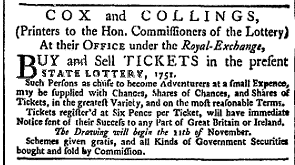Some of the newspaper and journal articles I found during my research are a bit too long or wordy to include in the main body of my essay. So I have made them into separate drill-down pages, and introduced some punctuation in my transcript so you don't get too breathless. Any comments are in [blue italics]. Please click any of the links on the left to get back.
The first lottery in England was authorised by Queen Elizabeth I in 1566. Annual lotteries were run from 1694 until 1826. Gambling of any kind was very popular and a canny Parliament looking for interest-free loans took advantage of the mood.
The English State Lottery is described in detail in the Times dated 9th February 1789. It was described as
"the STATE LOTTERY for 1788, begins drawing the 16th February 1789, the Prizes to be paid in full in June 1789."
There was one prize each of £30,000, £25,000, £20,000, £15,000, two prizes of £10,000, five of £5,000, ten of £2,000, twenty-four of £1,000, thirty of £500, 103 of £100, and 15,150 prizes of £18. In addition, the first and last drawn tickets got £2,000.
What is described as “The present Price of Tickets and Shares” was: a whole ticket £15 14s 0d; a half £8 2s, a quarter £4 2s, an eight £2 1s, and a sixteenth cost £1 1s (a guinea). Bear in mind that a labourer of the time was lucky to earn £20 a year, so the lottery was not really aimed at the working classes. But it was possible to buy a part-share - in the 1760s Surrey grocer Thomas Turner [see bibliography] writes of buying a 1/16th of a ticket, and his brother buying another.

On 22nd March 1790, the Argus (London) published a list of £25- and £20-prize-winning numbers, and also a list of blanks (by far the longer list!) resulting from the twenty-fourth day of drawing in the 1789 State Lottery. Since the only way of announcing winners was in the newspapers, it made sense - and more profit - to spread the results over as many days as possible!

